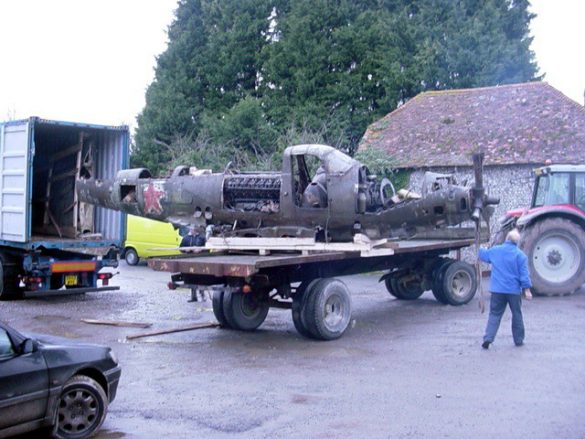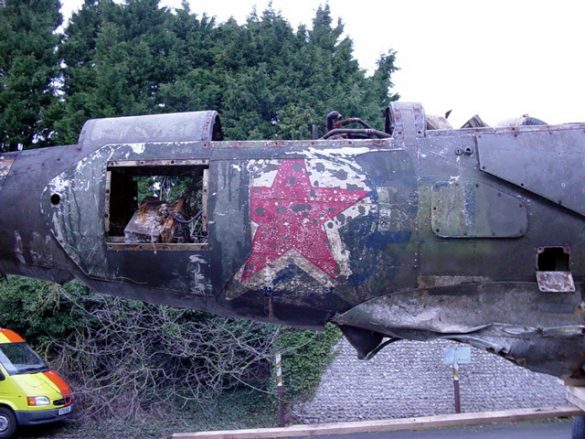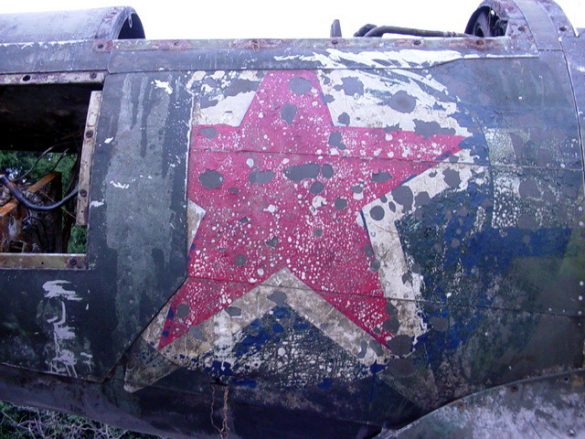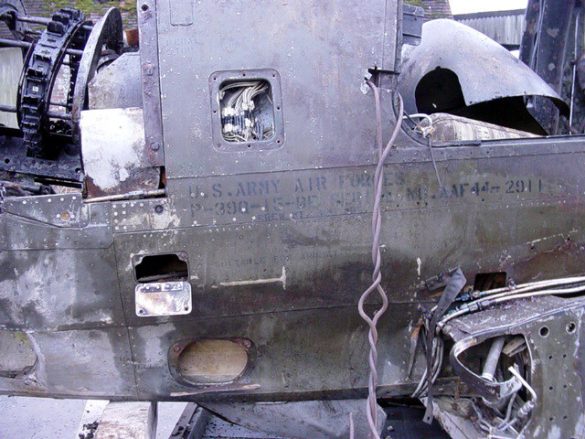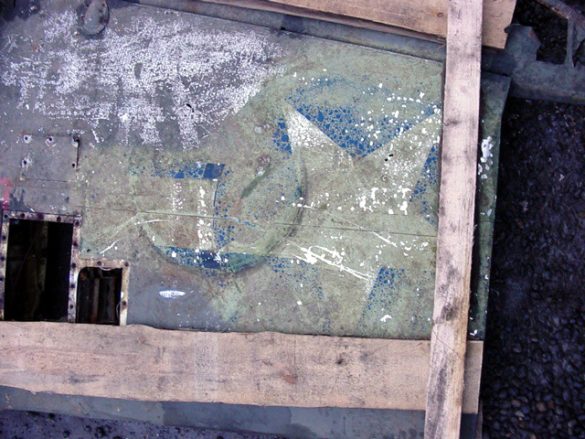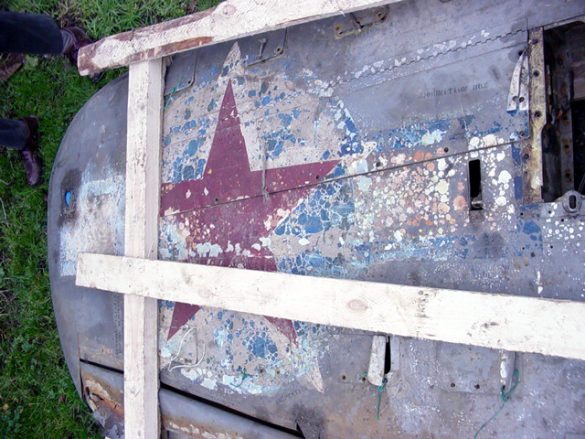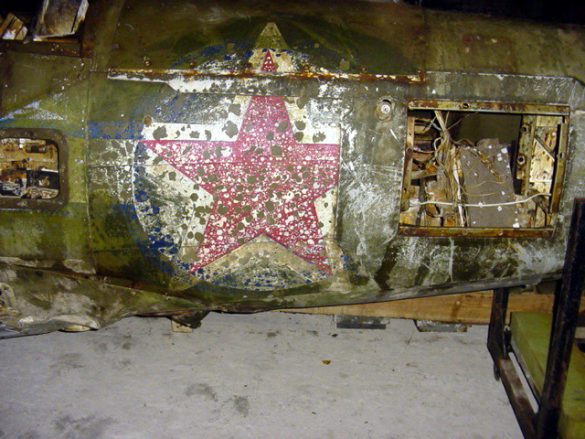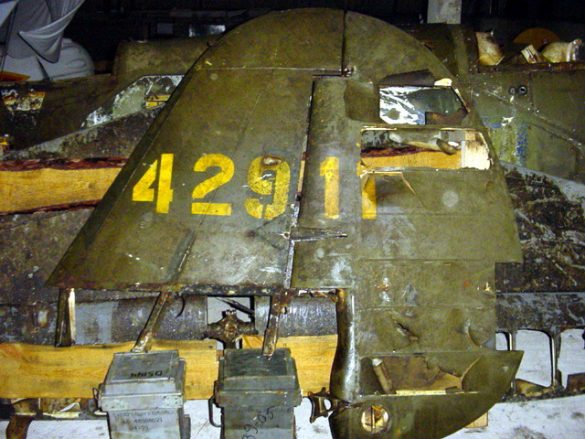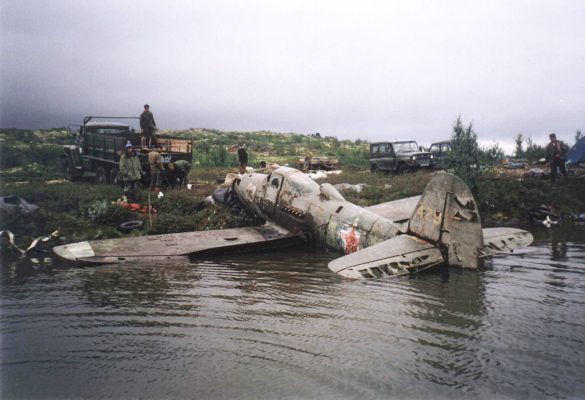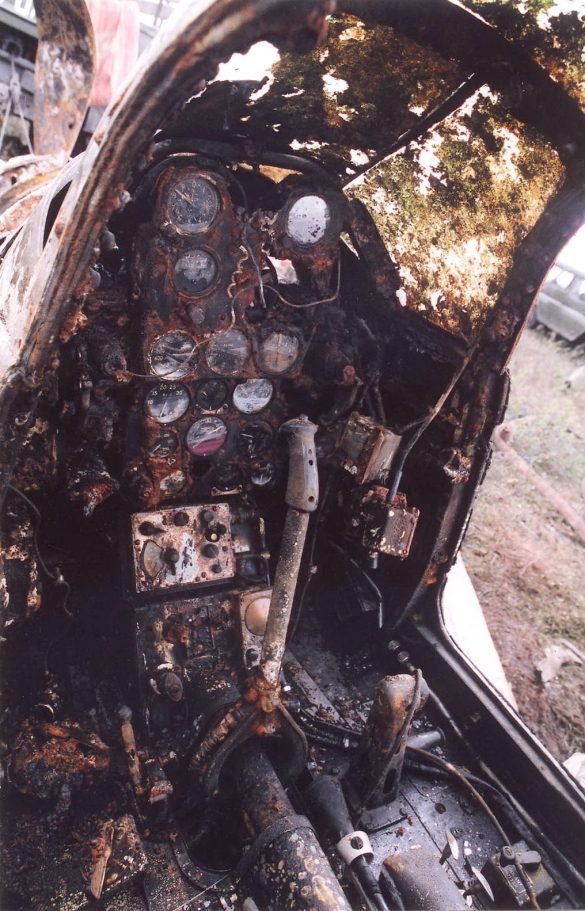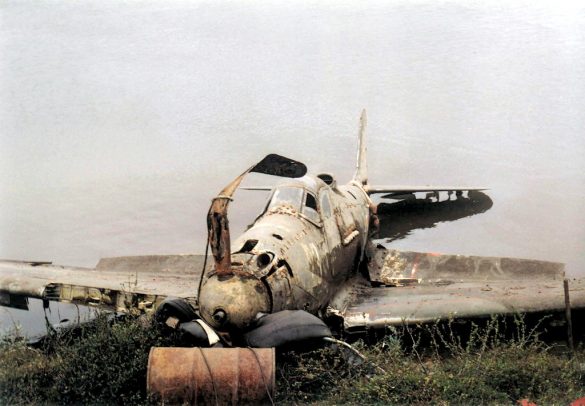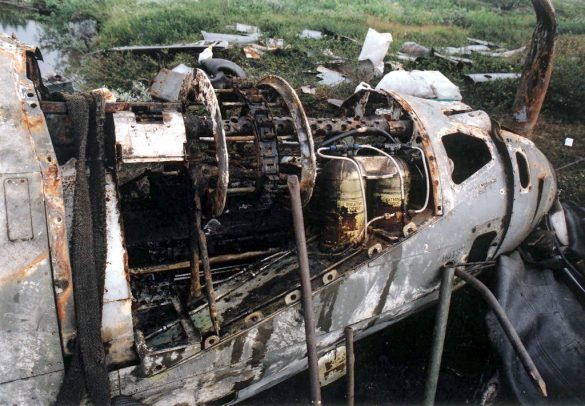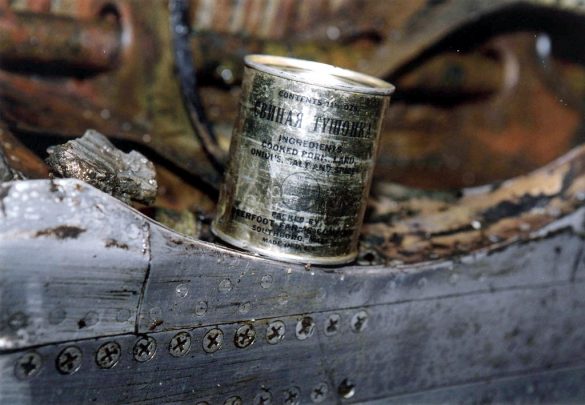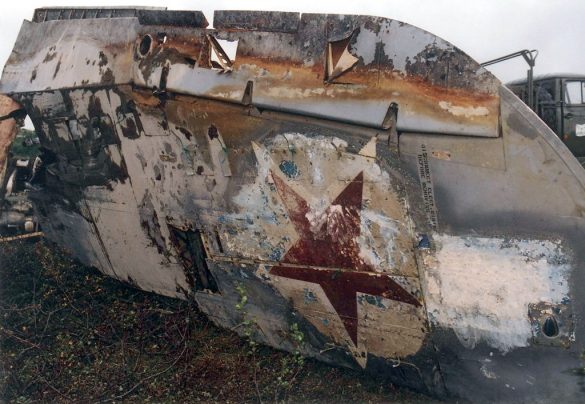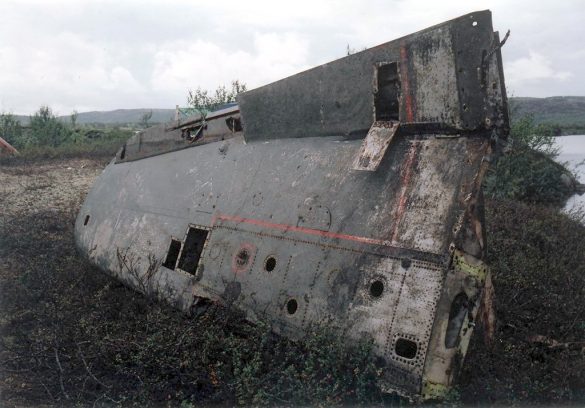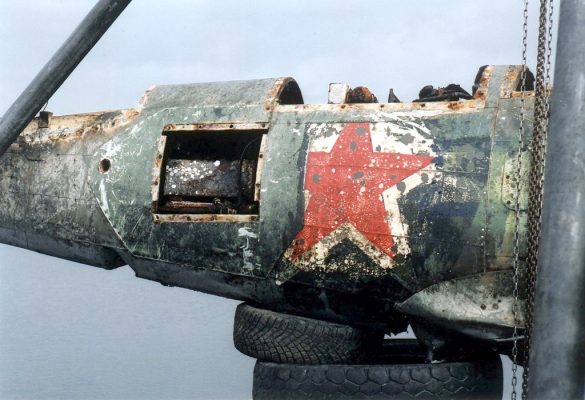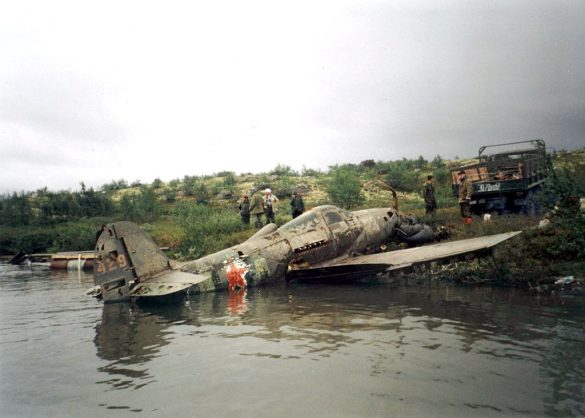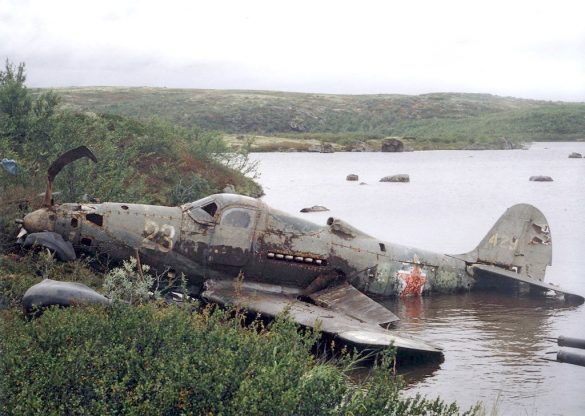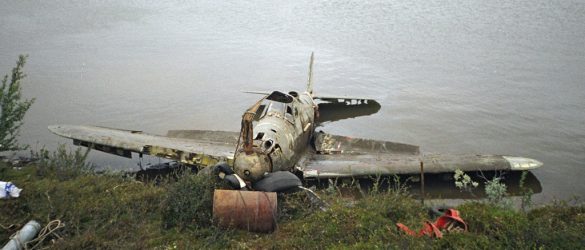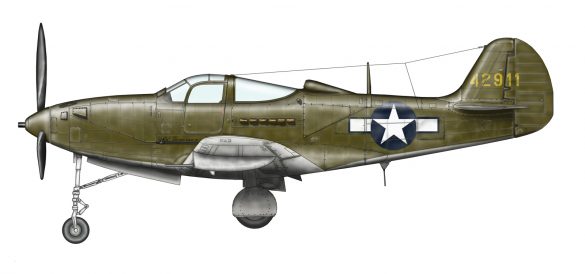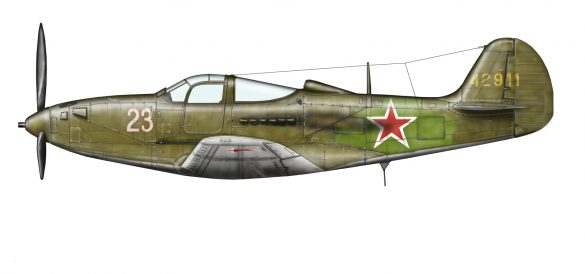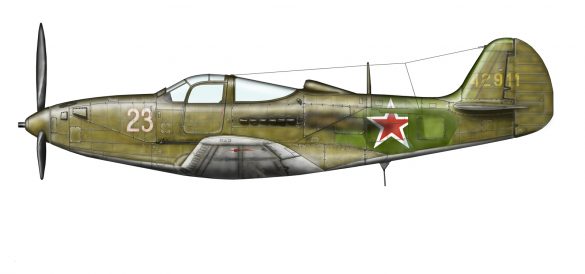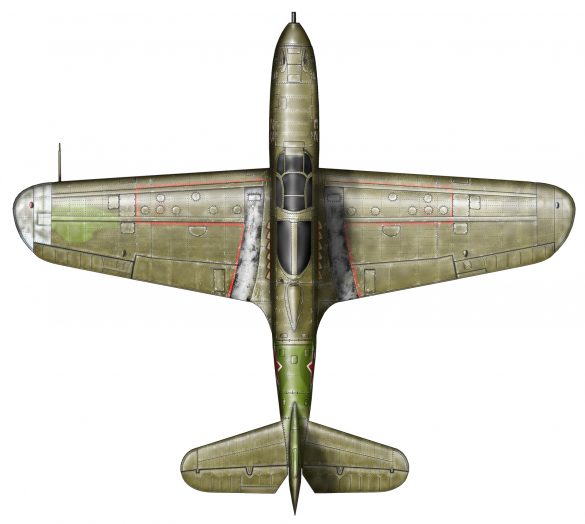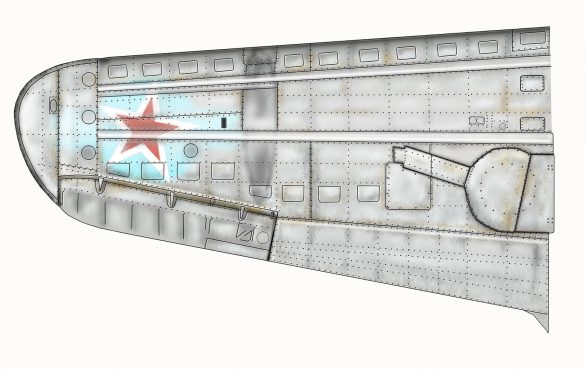Discovery
This amazing Bell P39 was located at the bottom of Lake Mart-Yavr within the Russian Arctic Circle in the summer of 2004. As with other recoveries over the years, it was discovered by a fisherman who saw the silt covered outline through the crystal clear water.
The P39 sat on the bottom of a shallow lake at a depth of 5m, covered and buried up to the top of the propeller spinner in fine silt. Covered in silt, no markings were initially visible but after a little brushing, a red star appeared together with a yellow serial on the fin and rudder. With the serial now known, a search through the archives showed the pilot had disappeared on a transfer flight in November 1944.
Taking advantage of the good weather, the recovery team used air bags, tripod frames and a truck winch to bring the P39 to the shore. It caused concern that when the P39 emerged both the cockpit doors were still closed. Usually, if it was a water landing, one or both would have been jettisoned allowing for a quick exit. If the lake had been frozen, the team would still have expected one door to be open following any force landing.
The reason soon became apparent; for some unknown reason, the pilot had not exited the P39 and his remains were located in the cockpit. Missing for 60 years, the pilot was buried on 6 October 2004 with full military honours at the Glory Valley Memorial, near the Litza Valley, NW of Murmansk.
The P39 was remarkably complete, only missing the starboard inboard leading edge. As is always the case with magnesium-based components, the wheel hubs and engine cam covers to the engine had dissolved over the years and disappeared.
An interesting discovery was that the wing 0.5in machine guns had been removed. This in itself was not unusual, but in the area for the ammunition trays the team discovered six cans of American stew and spare lengths of ammunition. The 11 1/2 oz food cans contained cooked pork, lard, and onions with spices and had been packaged by Beerfoot Farms Company, Southboro. Massachusetts. USA. Not all lend-lease supplies were hardware!
The main fuselage weaponry was in place including the Colt-Browning M4 37mm cannon that fired through the spinner with 30 rounds of ammunition. The two 0.5inch heavy machine guns were located over the cannon and fired through the propeller and each had 200 rounds of ammunition as well.
The most amazing discovery was in the document case on the starboard door. The team located the maintenance record book for this P39. Although a few pages had perished, the majority was still legible. Nearly all of the Russian information that follows concerning flight hours/dates, servicing and pilots’ names come from this unique document.
The P39 was easily disassembled before being transported to Moscow where it received its export licence. It was then transported to Jim Pearce’s facility in West Sussex where it is currently being cleaned up and inspected. This amazing and historic P39 is currently for sale.
History
Bell Aircraft Corporation P39Q-15BE 44-2911 was one of the last of the 1000 Q-15 examples built at Buffalo, New York under contract AC-40071. The allocation block priority number stated British – Russia – Block 7-1 although it is currently unclear what Britain had to do with ‘2911’ unless it was paying for this example under lend-lease agreements. ‘2911’ had been fitted with a 1200hp Allison V-1710-85 engine, serial No 43-168161.
Deliveries of the Bell model 26Q-15 began in August 1943; the last of this series being completed towards at the end of the year. Although the manufacturing cost was not stated, it is likely to have been in the region of $46,000, excluding items such as the propeller and radios.
In all, 4,905 P39Q models were produced and of these, 3,291 were issued to the Soviet Union under lend-lease agreements.
P39Q ‘2911’ was completed with standard Olive Drab upper surfaces and Neutral Grey under surfaces. It was finished with the stars and stripes of the AAF to both sides of the fuselage, port upper wing and starboard lower wing. On both sides of the fin the serial, ‘42911’ was painted.
On 23 November 1943 ‘2911’ was signed off as complete and became available for issue on 22 December. Even though displaying AAF markings, ‘2911’ became available to the Soviet Union and began its journey from the East Coast to the West Coast under the authorisation of the Air Transport Command. (ATC).
Before the start of her journey, ‘2911’ was fitted with a long-range belly tank. (Maximum range was normally 1050km). The ATC flew her 645km from Buffalo to the first stop of South Bends, Indiana where she arrived on 25 December. She was held there for a day due to bad weather before flying the 1050km to Fargo, North Dakota. She ‘remained over night’ on 30 December before flying the final 1090km to Great Falls, Montana on 31 December.
On 5 January she departed Great Falls and flew 3390km through Canada, stopping at a number of airfields before arriving at Fairbanks, Alaska on 9 January. ‘2911’ became one of 244 aircraft delivered to Fairbanks in January for onward delivery to Russia.
At Fairbanks on 9 January, ‘2911’ was accepted by the Reception Committee of the Soviet Red Arm Air Force Foreign Dept. The records indicate she had 20hrs of flight time including testing and delivery. Accepted, she now had to undertake a further flight through some of the most barren and desolate land on earth – Siberia.
The flight route from Great Falls to Fairbanks was the US segment of what became known as the ALSIB (Alaska –Siberia) route. This route accounted for 7,926 lend lease deliveries over a three-year period. From Fairbanks, the ferry flying was completed by the Soviet 1PAD (1 Ferry Aviation Division) and a separate regiment flew each leg. 1PAD had five PAP regiments.
Having already flown nearly 6,175km, ‘2911’ was made ready for the next leg of its journey. Usually a group of P39’s would be escorted by a lend-lease A-20 or B-25 on the Siberian segment of the ALSIB route. Critically, maintenance over these flight distances was very important.
Again the following comes from the maintenance records of ‘2911’.
On 1 February ‘2911’ left Fairbanks being flown by 1PAP. This 1,500km leg was via Nome, Alaska before landing at Anadyr across the Bearing Strait where ‘2911’ was serviced on 3 February. A pilot called Shishkin of 2PAP flew from Anadyr to Markovo 485km away where ‘2911’ seems to have stayed for a month. At Markovo on 4 March ‘2911’ was serviced before 2PAP continued flying ‘2911’ the 970km to Sejmchan. From Sejmchan it was the turn of 3PAP who flew ‘2911’ the 1,165km to Yakutsk where she was serviced on 6 March. From Yakutsk a pilot called Korolyov of 4PAP flew the 1330km to Kirensk where ‘2911’ was serviced on 9 March. The final leg was flown by 5PAP from Kirensk to Krasnoyarsk, a distance of 970km. From Buffalo, ‘2911’ had flown a total of 12,600km.
Krasnoyarsk was the end of the ALSIB ferry route for ‘2911’ and it is likely that the AAF markings were painted over here by 45ZAP with Russian colours. A red star with white outline was added to both sides of the fuselage and under both wings. Although it cannot be confirmed, it is likely ‘2911’ was then flown by 9PAP to Salekhard 1,935km to the NW. This airfield was often used by 7VA (7 Air Army) to collect and re-equip units. ‘2911’ was allocated to 773IAP, who were subordinated to 257 SAD (257 Mixed Aviation Division) of 7VA. It is possible 773IAP was being equipped with P39Q’s and ‘2911’ was marked up as ‘White 23’. ‘White 23’ then headed the 1,500km to its base at Novinka in Soviet Karelia.
On the 4 June, a pilot called Golovnyov undertook the first recorded flight of ‘White 23’ with 773IAP. He and possibly other pilots flew ‘White 23’ for the first six weeks until mid July when the unit moved to Videlitsa. ‘White 23’ was then involved in the Soviet Svir Operation against Finland between 21 June and 9 August. In late August the unit then moved to Mikkola. It is known 773IAP frequently clashed with the Finnish Air Force and is recorded as shooting down 6 Moranes and 1 Buffalo. In return at least 9 P39’s were lost to air combat and AAA.
From the records for ‘White 23’, we know that in June she flew 34hrs/37min/30 landings and in July, 35hrs/7min/34 landings. Unfortunately the maintenance records for this period were illegible although the crew chief for ‘White 23’ was called Vetlich.
During the Svir Operation, ‘White 23’ became the mount of Lt Ivan Ivanovich Baranovsky on 18 July.
In August ‘White 23’ seems to have been remarkably inactive. With only 4hrs/11min/3 landings, it is thought that during this period ‘White 23’ was returned to a repair facility to have remedial works undertaken to the airframe.
During testing and combat reports, the one thing the Soviets were discovering was that the P39 suffered a structural weakness of the rear fuselage. After thorough testing, the Soviet LII (Flight Research Institute) and TsAGI (Central Aero and Hydrodynamic Institute) recommended a number of improvements to be undertaken at repair workshops from mid 1944.
These were recorded as: –
Defect and modification. – Twisting of rear fuselage and skin deformation.
All Q models up to and including the Q21 to have the following.
a. Two additional skins around radio compartment hatches.
b. fuselage longeron reinforcing member
c. two supports to forward tailplane spar attachment joints
d. two plates to reinforce the port forward fuselage beam.
Items a and c are clearly visible on ‘White 23’. These skins have been added over the red star and have covered segments of it. Whether or not it was deemed important, the star was not repainted.
All Q series models were to have the following work undertaken to the fin.
a. reinforce fin leading edge with additional skin.
b. add third fin/fuselage attachment point.
c. reinforce the forward and rear post with additional profiles.
d. additional plates at the middle of the rudder hinge.
Items a and b were also visible on ‘White 23’. The starboard skin of the fin was unrivetted and removed. The third attachment was added and refitted along with the additional leading edge skin. On completion the starboard skin to the fin was resprayed masking out the number, again visible in the photos.
Additionally, operating procedures were also altered to cover dive speed limit, rudder deflection limit and hard landings when highly loaded. Items relating to the centre of gravity were also implemented to reduce the weight at the rear.
On completion of this work, ‘White 23’ returned to 773IAP. After the Svir Operation the Finnish Front had stabilised and on 4/5 September the Soviet Union and Finland agreed a ceasefire. A condition of this was the removal of German forces from Northern Finland.
The whole 7VA were then transferred to the Murmansk area for the next operation in early October and 773IAP was attached to 1GSAD (1 Guards Mixed Aviation Division). This offensive was against the German bases in Northern Norway and those still occupied in Northern Finland including Petsamo and Luostari. It seems 773IAP moved to Murmashi airfield, just south of Murmansk, in early October. Again from the maintenance records for ‘White 23’ we know that in September she flew 15hrs/45min/16 landings and in October she flew 12hrs/38min/13 landings.
The first phase of the Soviet Petsamo-Kirkenes Operation began on 7 October with land and amphibious landings. Poor weather meant there was little air support for both sides. The weather broke on the 9 October and the last major air battle of the Arctic occurred between the Soviet Air Forces and III and IV/JG5. On this day the Luftwaffe claimed 85 victories (the 3000th of JG5) for the loss of one German pilot. ‘White 23’ flew twice this day for 2hr 12min.
On 12 October Luostari airfield was captured and was soon used by the Russians to fly in supplies and take out the wounded. Petsamo was captured on 15 October.
On 20 October, units of the 7VA flew close support missions for the ground forces and this is likely to have been 773IAP ‘s main task. We do know that air support were attacking German artillery batteries and that ‘White 23’ flew twice this day for 2hr 10min. On the second sortie ‘White 23’ was hit by flak damaging the starboard fuel tank and filler tube. Returning to Murmashi, the damage was repaired later that day. ‘White 23’s’ total load was confirmed as 449kg for all sorties, 333kg fuel, 26kg oil and 90kg of other, probably ammunition.
Two more sorties were flown on 21 October and one on the 29 October. (Kirkenes was liberated on 25 October). On 29 October 773IAP received instructions to undertake replacements of certain items. They are listed as “ the horizontal stabilizer changed to a reinforced one and front attachment point of the stabilizer reinforced. It is thought this was additional work not connected to the alterations that occurred in August.
On 19 November ‘White 23’ flew its last mission. At this time 773IAP had 26 P39’s of which 22 were serviceable. The unit were ordered to fly from Murmashi to Luostari airfield, captured a month before. The P39’s were loaded up with tins of food and additional ammunition. Murmashi was now to far from the front line and fighting was still continuing into Norway. The P39’s took off to fly the 65 miles NW to Luostari. Below is the archive except from the 773IAP records.
“In the vicinity of Lake Chapr, 15km before the destination airfield, pilot Baranovsky shouted over the radio the order to port and turned 90-120 degrees and departed the squad, losing height. The squadron commander ordered him and his wingman to return in line with the group. The wingman did, but Baranovsky went out of sight and did not arrive at Luostari airfield. The pilot and aircraft were not found, pilot missing. The blame was apportioned to Baranovsky who issued the order to depart the group, and Squadron Commander Zaitsev who did not trace Baranovsky to his force-landing site”
Why Lt Baranovsky left the group is unclear. If there was a mechanical problem, he was surely close enough to Luostari to make a force landing. All we know is he was found at Lake Mart-Yavr, 29km SE of Luostari. He seems to have prepared for the force landing by unbuckling his harness and attempting to belly-land on the still thin winter ice. There was no attempt to escape the sinking P39 and it is possible he was either knocked out or killed instantly during the force landing. Lt Baranovsky was 22 years old and was an experienced pilot having flown 90 operations with 773IAP. On his remains were found the Glory Order III Degree and Military Red Banner Order medals.
Thanks must go to Jim Pearce for again letting me study and write about this remarkable aircraft, Kjetil Aakra, Rabe Anton, Carl–Fredrik Geust, Ilya Grinberg, Kari Lumppio, Erik Pilawskii and Valeriy Romanenko for all their help in completing this story.
Illustrations © Kjetil Aakra 2006
Photos © Boris Osetinskij 2006


